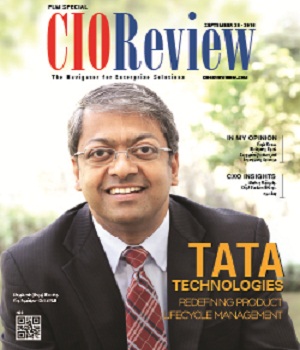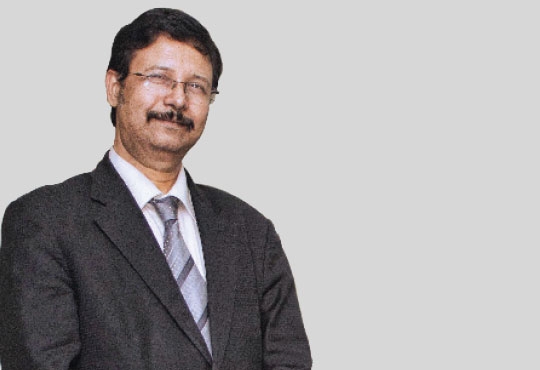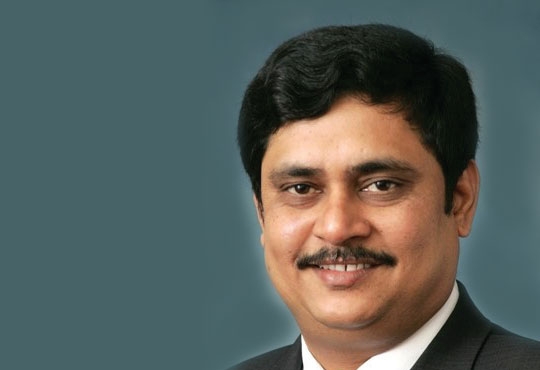
Tata Technologies - Redefining Product Lifecycle Management
CIOReview Team | Monday, 20 February 2017, 07:20 IST
 Product Lifecycle Management acts as the product information backbone for an organisation and it is necessary that it covers the complete lifecycle of a product, integrating cross-discipline product development, all the way from capturing product requirements to manufacturing and field service, enabling collaboration and flexible processes across the extended enterprise. When it comes to decision-making at the different levels, there are several challenges. Developing today’s products places higher demands on engineers. For example, increased software content in products requires a tighter integration between mechanical, electrical and software engineering teams; mandating decisions to be made in the context of mechanics, electronics, and product software. Even more challenging is that enterprises have to decide early in their design cycle, which capabilities will be driven by each of these disciplines. Now, each decision is more integrated with the rest because a decision in a mechanical characteristic may need to be accounted for not just in the physical structure but also in the controls.
Product Lifecycle Management acts as the product information backbone for an organisation and it is necessary that it covers the complete lifecycle of a product, integrating cross-discipline product development, all the way from capturing product requirements to manufacturing and field service, enabling collaboration and flexible processes across the extended enterprise. When it comes to decision-making at the different levels, there are several challenges. Developing today’s products places higher demands on engineers. For example, increased software content in products requires a tighter integration between mechanical, electrical and software engineering teams; mandating decisions to be made in the context of mechanics, electronics, and product software. Even more challenging is that enterprises have to decide early in their design cycle, which capabilities will be driven by each of these disciplines. Now, each decision is more integrated with the rest because a decision in a mechanical characteristic may need to be accounted for not just in the physical structure but also in the controls.
To address all these challenges, enterprises need a PLM solution provider who has in-depth knowledge of manufacturing and engineering. Tata Technologies, an enterprise that believes in making product development dreams a reality by designing, engineering and validating the products of tomorrow for the world’s leading manufacturers, follows an engineering and manufacturing based approach towards PLM. “Product development and manufacturing are in our DNA. We nurture and develop people who not only understand manufacturing, but also know a whole lot about software development. It is a fantastic confluence of software, engineering and manufacturing capabilities which brings non-linear returns to our customer,” says Shreekanth (Shree) Moorthy, Vice President - Global PLM at Tata Technologies.
Beyond just CAD
According to CIMdata, a PLM industry analyst, almost 75 percent of companies are not realizing full value from their PLM investment. “This is because, most people associate PLM purely with engineering and that too only with CAD data management. If you are just doing that, you do not see real benefit across the enterprise, because CAD data management is only a portion, a sliver of what PLM technologies can deliver today. We need to advance from plain old CAD data management to holistic systems engineering, from requirements management to Digital Manufacturing, which includes building entire factories in 3D before a single brick is laid,” says Shree Moorthy.
Taking us through the PLM process, he says, “In a New Product Introduction (NPI) program, initially, there would be requirements coming from the customer, manufacturing and R&D.There might also be requirements from regulatory compliance. Once these requirements come in, they are decomposed into individual pieces which are sent to the product design people, electrical design people or software development people and so on. Once that happens, people start to ideate collaboratively around the final product. From styling, it goes to Design, from Design it goes on to CAE to evaluate the design. By this time within the product development process, you start realizing that there are a whole bunch of people sharing information and that information is getting morphed into other pieces of information and used in other domains. Then, we come to manufacturing, where we need to be able to create a flexible and intelligent manufacturing process that will allow me to continuously improve that manufacturing facility overtime. Based on the data analysis over the years for every piece of the product data, be it a product feature or material, there are hundreds of pieces of manufacturing data, numerous finer nuances that need to be managed. So you can appreciate immediately that, not only does a whole lot of data needs to be managed, but it also needs to be easily retrievable and available for the collaborative working of thousands of engineers working together to make sure that the product would come out right the very first time and on schedule. When we talk about managing data, it is extremely important to also talk about the BOM, or the Bill of Materials. The BOM is essentially a list of all the parts that go into a product. Without going too technical into the various kinds of BOMs that need to be managed, let me just say that the industry has advanced from maintaining just the CAD BOMs (As-Designed BOM), to managing and maintaining As-Built BOMs and As-Serviced BOMs. Let’s take a commercial airplane as an example. Most airplanes that we fly in today are probably 20-30 years or more old. The aircraft that rolled out from its hanger 30 years ago is not the same aircraft that we fly in today. Surely, WiFi at 36,000 feet and personal infotainment did not exist 30 years ago on that original airplane. Technological advances and regulatory changes over the years have resulted in all these airplanes being constantly modified. From a data management standpoint, the PLM systems will need to manage information about the aircraft for the 40 years or the life of the aircraft. This hopefully gives you a kind of broad sense of what the PLM landscape looks like”.
Product Development
The Tata Technologies’ value proposition starts with product development at the centre of everything they do. “Including me, a lot of us have spent our early years in core engineering and also at manufacturing plants. Like I said before, Engineering and Manufacturing are really embedded in our DNA. This concentration on engineering and manufacturing gives us the ability to bring innovation into all of our solutions. When we do that constantly, our customers start seeing us as their partner of choice in their journey; and that is priceless,” shares Shree Moorthy.
He explains, “Way too often, we find that customers find it easy to just tell us what needs to be done. From their perspective, they think they know their landscape and hence the solution. From a solution vendor’s perspective, surely it is very easy to find a bunch of software developers and do what the customer is asking. Our advice to the customer usually is to take a step back and tell us what their problem is and we will talk about the different types of solutions later. This strategy gives us a forest-for-the-trees view, thus ensuring that the customer gets the maximum value”.
Right at the beginning of the customer engagement, the Tata Technologies team makes sure it understands the customer’s pain point. “Let’s take an example. Let’s say a customer comes to us and asks us to implement Change Management in their PLM system. Let’s say they tell us that while the final design of the product was collaboratively signed off on, changes in customer requirements never made it to the shop floor and hence, the product was not delivered as per the end customer’s expectations. To our customer, the issue may be Change Management. But to us, we see Change Management simply as a symptom of perhaps a larger issue or an accumulation of several other issues. Perhaps it’s a process issue that’s more systemic. This necessitates studying their current processes before making any judgement calls on what may or may not be wrong. We have high-end consulting products; one is called PLM Scan which is essentially a digital maturity assessment model. We look at the customer’s IT infrastructure, PLM infrastructure, manufacturing processes, organizational structure, their processes in great detail; we look at all that in totality and then try to figure out what are they really doing, before deciding on what may or may not be a problem that needs to be fixed,” says Shree Moorthy.
He continues, “If the customer is talking about change management being his or her problem, we try to figure out what is causing it. It could be various aspects. It might also be due to the PLM system not having been implemented properly by the earlier implementer. There are various reasons why something might happen, but before we go ahead and jump on a solution we need to understand the larger landscape. That is what PLM Scan gives us. But we need to solve their problem and see the problem in context of other things within the enterprise. Once the PLM Scan tells us what is wrong and what needs to be fixed, we employ another product which we call as PLM Blueprinting, wherein we architect the entire blueprint for PLM in the company including re-engineering processes (TO-BE processes). The output of our PLM Blueprinting exercise is a Master Plan, a bible if you will, of their PLM journey. This blueprint contains the architecture, data model, domain-wise solutions, detailed project plans, application sun-down strategies, and Organizational Change Management and Training amongst other things.”
Skill Development Initiative
Tata Technologies provides a ‘Ready Engineer’ program that essentially connects up to the universities in India and abroad. “Very often the biggest complaint that all of us in the industry have, is the gap between what academia is teaching, and the kind of talent that is needed by us. We end up having to re-train fresh graduates for about a year and a half before they can really become solid consultants. We are looking at Ready Engineer as a skill development initiative to make sure that students that come out of these universities are well prepared, enabling them to bring significant value to the industry, at a much faster rate,” adds Shree Moorthy.
Moving ahead, Tata Technologies is all set to continue being the number one partner to the manufacturing industry. “I want the Tata Technologies name to become synonymous with PLM. As long as you are a manufacturing company with the hunger to excel in your industry and you want technology to provide that competitive advantage, we will be there to help you,” concludes Shree Moorthy.
CIO Viewpoint
End to End Supply Chain Planning is the Need of...
By Abel Correa, CIO , Arvind Lifestyle Brands
Managing Insurance Portfolio through a Smartphone
By Mehmood Mansoori, Member of Executive Management - IT Innovation & CEM, HDFC ERGO General Insurance Company
Optimize routes with Central level integration
By Tarun Anand, GM - IT, Mother Dairy Fruit & Vegetable
CXO Insights
The Monumental Shift in Traditional PLM Centric...
By Dr. Chandan Chowdhury, Managing Director, Dassault Systemes India
Benchmarking Report Administering organizations...
By Nagi Kasinadhuni, GM, Communications, APAC, Dimensions Data India
Embracing Cloud-Communications for a...







